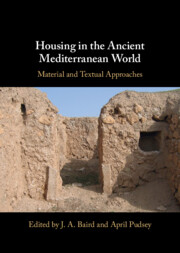Book contents
- Housing in the Ancient Mediterranean World
- Housing in the Ancient Mediterranean World
- Copyright page
- Contents
- Figures
- Tables
- Contributors
- Acknowledgements
- Introduction
- 1 Kinship ‘In the Halls’
- 2 Domesticating the Ancient House
- 3 Mind the Gap
- 4 A Family Affair
- 5 Textiles in Alkestis’ thalamos
- 6 Architectural Rhetoric and the Rhetoric of Architecture
- 7 The Reconstruction of an Agricultural Landscape
- 8 Mudbricks and Papyri from the Desert Sand
- 9 Housing and Community
- 10 The Elusive vestibulum
- 11 Living in the Liminal
- 12 Experiencing Sense, Place and Space in the Roman Villa
- 13 Houses and Time
- 14 Spaces of Desire
- 15 A Response: ‘Using the Material and Written Sources’ Revisited
- Index
- References
8 - Mudbricks and Papyri from the Desert Sand
Housing in the Ptolemaic and Roman Fayum
Published online by Cambridge University Press: 08 July 2022
- Housing in the Ancient Mediterranean World
- Housing in the Ancient Mediterranean World
- Copyright page
- Contents
- Figures
- Tables
- Contributors
- Acknowledgements
- Introduction
- 1 Kinship ‘In the Halls’
- 2 Domesticating the Ancient House
- 3 Mind the Gap
- 4 A Family Affair
- 5 Textiles in Alkestis’ thalamos
- 6 Architectural Rhetoric and the Rhetoric of Architecture
- 7 The Reconstruction of an Agricultural Landscape
- 8 Mudbricks and Papyri from the Desert Sand
- 9 Housing and Community
- 10 The Elusive vestibulum
- 11 Living in the Liminal
- 12 Experiencing Sense, Place and Space in the Roman Villa
- 13 Houses and Time
- 14 Spaces of Desire
- 15 A Response: ‘Using the Material and Written Sources’ Revisited
- Index
- References
Summary
The Fayum oasis is key to our knowledge of houses in Roman Egypt. The villages and necropolises there have long attracted investigators focusing – in a more or less scientific way – on written documents, especially papyri, and material remains. Recently renewed research, including surveys and excavations, has supplemented the earlier evidence with new archaeological and textual data of the Hellenistic and Roman occupation of the area. This chapter gives an overview of what is known of the housing of the Fayum during that time. By integrating archaeological housing evidence from Fayum sites with papyrological information, this chapter aims to demonstrate that only an approach taking into account both the material and textual sources can result in a comprehensive picture of the appearance, layout, value, inhabitants and occupation history of individual buildings (for example, change of ownership through sale or the division of a single house among various house owners) within the context of entire village quarters. Moreover, this interdisciplinary method allows an improved understanding of the house types that coexisted on the Fayum sites during the Hellenistic and Roman periods, and situates the Fayum evidence in the context of housing in the Graeco-Roman Mediterranean.
- Type
- Chapter
- Information
- Housing in the Ancient Mediterranean WorldMaterial and Textual Approaches, pp. 261 - 299Publisher: Cambridge University PressPrint publication year: 2022

